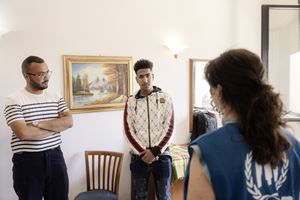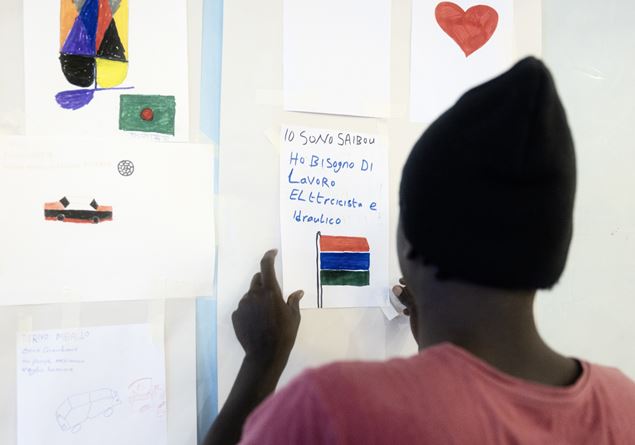They are thirteen, fourteen, seventeen years old. Sometimes less, even if they declare a higher age for fear of being sent back. They walk for months, cross invisible borders, flee from villages where there is no longer school, no bread, no future. You find them in the stories of NGO workers, in the landings on Lampedusa, in family homes in the South, in the centers of big cities. They are unaccompanied foreign minors, almost mythical figures of our time: teenagers who have seen more war, hunger and violence than many adults would bear. On June 30, 2025 they were 16,497 in Italy, the87.5% malecoming mainly from Egypt, Ukraine, Gambia, Tunisia and Guinea. Numbers that are growing and which, more than the numbers, reveal a collective wound.
Chiara Cardoletti was appointed Representative for Italy, the Holy See and San Marino of the UNHCR, the UN Refugee Agency, in June 2020
«The challenges are increasingly greater – explains a Christian family Chiara Cardoletti, UNHCR representative for Italy, the Holy See and San Marino – because the number of children setting out on the journey is increasing and, above all, the share of minors under 14 is increasing. They are children and pre-adolescents who arrive with “very large wounds in their bodies and hearts”. You just need to look into their eyes to understand where they come from.” They carry no luggage, often just a dead phone or a crumpled photo of their brother, their mother, of a house that perhaps no longer exists.
In the same first six months of the year, 2,572 of them disappeared from the centers of reception. Missing means that one morning their bed is empty, their backpack is no longer there, and no one knows where they went. «I don’t think all these kids leave the centers to look for family members in Europe – clarifies Cardoletti –. Many are pushed by traffickers towards large Italian cities, where they end up in illegal construction, the black market or, in the worst cases, sexual exploitation. They don’t disappear: they reappear elsewhere, in much riskier conditions.” It is a hard truth to accept, but necessary to understand the dimension of the phenomenon.

Italy has a first and second reception system which, on paper, should offer mediation services, scholastic support, orientation and professional training. In reality, the geography of reception resembles an irregular archipelago: virtuous centres, capable of building solid integration paths, coexist alongside unprepared, overloaded structures, sometimes even lacking cultural mediators. «There are excellent situations, where young people can really imagine a future in Italy – says Cardoletti -. But there are also many centers that do not offer adequate services. And when a minor sees no prospects, he leaves. It’s human: at sixteen, if you don’t see anything for yourself, you try to look for it elsewhere.”
The new project was born from this awareness “Enhancing Reception and Protection Services for Unaccompanied Children in Italy”, promoted by the Ministry of the Interior, Switzerland and UNHCR, active in Lombardy, Puglia, Basilicata and Campania. Regions chosen not only for the high number of arrivals, but for the complexity of the phenomenon in the area: ports, transit centers, large cities, rural areas where reception is left to the good will of a few. «The objective is to create virtuous and replicable models – underlines Cardoletti -. Places where every minor is followed with an individual, scholastic or professional path, and where he is not perceived as a number to be managed but as a child to be accompanied”.
The aim is also to harmonize services. In Italy, in fact, uniform standards are lacking: the quality of reception varies from province to province, from center to centre. The project aims to reduce these fractures by supporting UNHCR and Save the Children with local operators. The latter, in particular, works on children through recreational activities, psychosocial interviews and moments of listening. «Through play and informal exchange we understand their real age, the path they have taken, their fears – says Cardoletti –. From there the real protection work begins.”
Operator training is another critical point. Those who work in the centers often find themselves dealing with deep traumas, unknown languages, deep-rooted fears. «Training is essential, but resources are not infinite – admits Cardoletti –. Operators must know how a thirteen-year-old who has been through a war speaks, how a child who is a victim of trafficking behaves, how to accompany a minor who has never had a reliable adult in his life.”
The pressure of the families who remained in their country of origin also weighs on their path. Quite a few minors are sent to Europe with the often unrealistic expectation of immediately finding a job and sending money home. «There is a huge pressure on these kids – observes Cardoletti –. And traffickers exploit exactly this vulnerability. They promise them jobs that don’t exist, or they lead them into illegal circuits from which it is very difficult to escape.”
What makes everything more complex is Europe’s position. Many countries ask Italy to retain and manage attendance, criticize our limits, but few assume a shared responsibility. «Switzerland represents a positive example – says Cardoletti –. He doesn’t just judge: he collaborates, supports, participates. And this makes the difference, because managing a thirteen year old Italian is difficult; managing a thirteen-year-old who arrives alone from the other side of the Mediterranean is a responsibility that cannot be left solely to the country of arrival.”
The alarm is growing especially in cities, where the issue of lonely minors has become one of the main concerns of the administrationsthe. «The Italian municipalities are very worried – confirms Cardoletti -. And this is why the network of metropolitan cities and the Charter for Integration were born, a place to share practices, data, fears and solutions. Together with ANCI we are building a method, because no city should feel alone.”
November 20, World Children’s and Adolescent Rights Day, often risks becoming a rhetorical ritual. This year, however, the presence of these kids forces us to change our outlook. «Unaccompanied minors are not a problem to be protected from – states Cardoletti -. These are kids who need help. Investing in their protection is a benefit for everyone: for them, for us, for our cities.” And he adds a warning: «Ignoring them doesn’t make them disappear. It only makes them more vulnerable to criminal networks.”
The final question is the simplest and the most difficult: Is building a future for these kids possible? «Yes, it’s possible – replies Cardoletti –. But we need everyone, institutions and citizens, to roll up their sleeves. Because every minor who arrives brings a dream. And there is nothing more human than trying to make it happen.”


